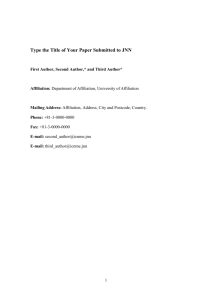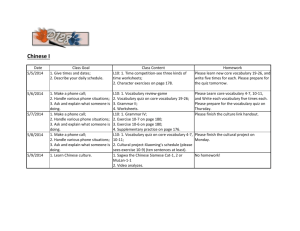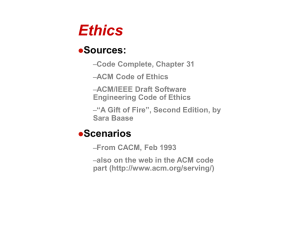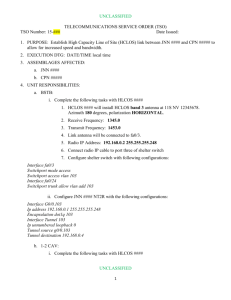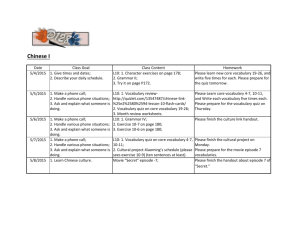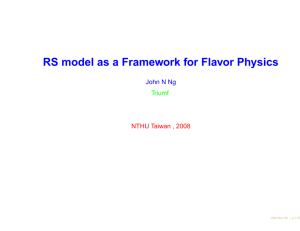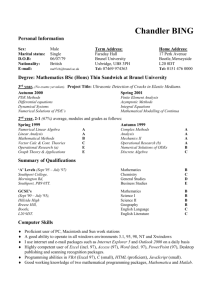Chern character
advertisement
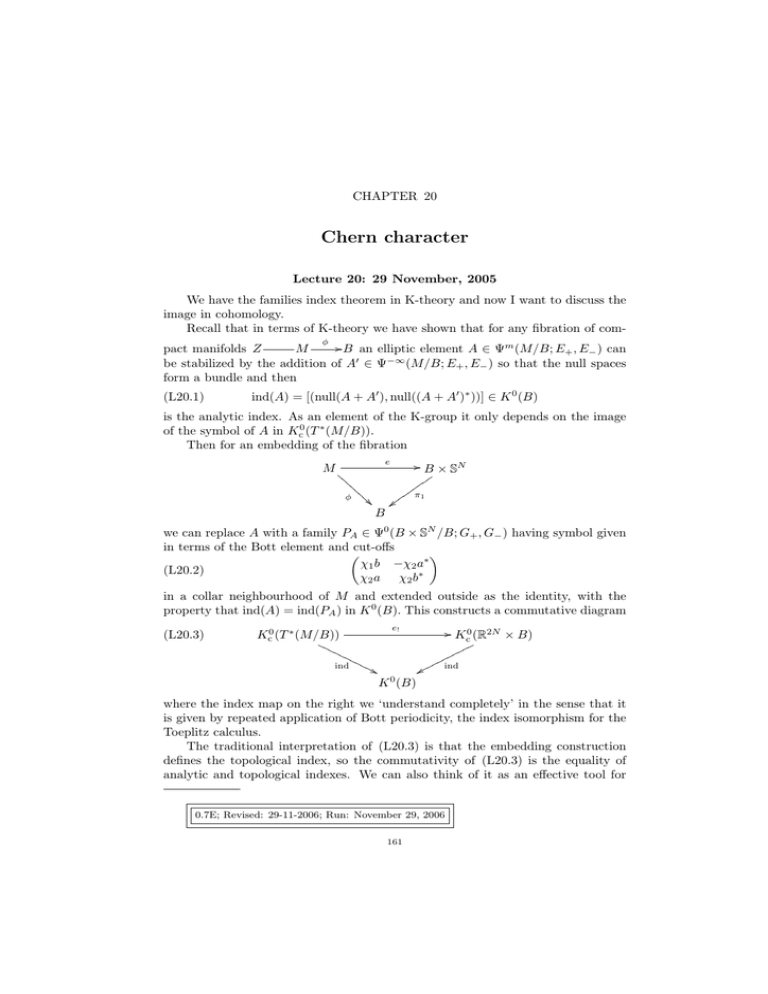
CHAPTER 20
Chern character
Lecture 20: 29 November, 2005
We have the families index theorem in K-theory and now I want to discuss the
image in cohomology.
Recall that in terms of K-theory we have shown that for any fibration of comφ
/ B an elliptic element A ∈ Ψm (M/B; E+ , E− ) can
M
pact manifolds Z
be stabilized by the addition of A′ ∈ Ψ−∞ (M/B; E+ , E− ) so that the null spaces
form a bundle and then
(L20.1)
ind(A) = [(null(A + A′ ), null((A + A′ )∗ ))] ∈ K 0 (B)
is the analytic index. As an element of the K-group it only depends on the image
of the symbol of A in Kc0 (T ∗ (M/B)).
Then for an embedding of the fibration
e
M@
@@
@@
@
φ @@
B
/ B × SN
ww
ww
w
ww π1
w{ w
we can replace A with a family PA ∈ Ψ0 (B × SN /B; G+ , G− ) having symbol given
in terms of the Bott element and cut-offs
χ1 b −χ2 a∗
(L20.2)
χ2 a χ2 b∗
in a collar neighbourhood of M and extended outside as the identity, with the
property that ind(A) = ind(PA ) in K 0 (B). This constructs a commutative diagram
(L20.3)
Kc0 (T ∗ (M/B))
NNN
NNN
NN
ind NNN
'
e!
K 0 (B)
/ K 0 (R2N × B)
c
pp
p
p
p
ppp
px pp ind
where the index map on the right we ‘understand completely’ in the sense that it
is given by repeated application of Bott periodicity, the index isomorphism for the
Toeplitz calculus.
The traditional interpretation of (L20.3) is that the embedding construction
defines the topological index, so the commutativity of (L20.3) is the equality of
analytic and topological indexes. We can also think of it as an effective tool for
0.7E; Revised: 29-11-2006; Run: November 29, 2006
161
162
20. CHERN CHARACTER
computing the index. This will be more apparent in the generalization to producttype operators below.
L20.1. Review of Chern-Weil theory. Let E −→ X be a complex vector
bundle over a compact manifold. Then E always admits an affine connection which
is to say a first order differential operator ∇ ∈ Diff 1 (X; E, Λ1 ⊗ E) :
∇
C ∞ (X; E) −→ C ∞ (X; Λ1 ⊗ E)
(L20.4)
which has the property
(L20.5)
∇(f u) = df ⊗ u + f ∇u ∀ f ∈ C ∞ (X), u ∈ C ∞ (X; E).
If ∇ is a connection on E and a : E −→ Ẽ is a bundle isomorphism then
˜ = a∇(a−1 ũ) is a connection on Ẽ. If E = CN is trivial then d itself, acting on
∇ũ
the coefficients, is a connection. If ρi ∈ C ∞ (X) is a partition of unity and ∇i is a
connection on E over an open set containing the support of ρi then
X
(L20.6)
∇=
ρi ∇i
i
is a connection on E. Combining these observations we see that any complex bundle
does indeed admit a connection.
Any connection has a natural extension to a superconnection, which is to say
an operator ∇ ∈ Diff 1 (X; Λ∗ X ⊗ E) which satisfies
(L20.7) ∇(α ⊗ u) = dα ⊗ u + (−1)k α ⊗ ∇u ∀ α ∈ C ∞ (X; Λk ), u ∈ C ∞ (X; E), ∀ k.
The superconnection corresponding to an ordinary connection clearly satisfies the
grading condition
(L20.8)
∇ ∈ Diff 1 (X; Λk ⊗ E, Λk+1 ⊗ E) ∀ k.
The sign change corresponds to anticommuting ∇ past k wedge factors. Namely
we can just insist on (L20.7) to get the superconnection with the connection on the
right side; of course one still needs to check that the result is consistent. I will not
distinguish between the connection ∇ and the superconnection it defines.
This allows us to define the curvature as the square of the connection which is
always a bundle map
(L20.9)
C ∞ (X; Λ2 ⊗ hom(E)) ∋ ω∇ = ∇2 ∈ Diff 2 (X; E, Λ2 ⊗ E).
To see this, just observe that ∇2 commutes with multiplication by any smooth
function
∇2 (f u) = ∇(df ⊗ u + f ∇u) = d2 f ⊗ u + (df ⊗ ∇u − df ⊗ ∇u) + f ∇2 u = f ∇2 u.
˜ = a∇a−1 is the transformed
If a : E 7−→ Ẽ is a bundle isomorphism and ∇
−1
˜ is aω∇ a . A connection on E induces a
connection then the curvature of ω̃ of ∇
connection on the dual bundle E ∗ by demanding that
(L20.10)
du∗ (u) = ∇∗ u∗ (u) + u∗ (∇u) ∀ u∗ ∈ C ∞ (X; E ∗ ), u ∈ C ∞ (X; E).
The curvature of ∇∗ is the transpose of the curvature of ∇. Similarly if E and
F are bundles with connections ∇E and ∇F then the direct sum has the obvious
connection ∇E + ∇F with curvature ωE + ωF . Connections on E and F also induce
a connection on E ⊗ F where for any sections
(L20.11)
∇E⊗F u ⊗ v = ∇E u ⊗ v + u ⊗ ∇F v.
LECTURE 20: 29 NOVEMBER, 2005
163
The curvature of this connection is easily computed
(L20.12)
ωE⊗F = ωE ⊗ IdF + IdE ⊗ωF .
Combining these two constructions we see that hom(E, F ) also acquires a connection from connections on E and on F. Namely if we identify hom(E, F ) = F ⊗ E ∗
the connection is the tensor product of ∇F and ∇∗E . Alternatively one can see that
the commutation formular
(L20.13)
(∇a)u = ∇F (au) − a(∇E )u, ∀ u ∈ C ∞ (X; E)
defines the action of the connection on a ∈ C ∞ (X; hom(E, F ). Bianchi’s identity,
which comes from computing ∇3E in two ways, then becomes the identity
(L20.14)
∇E ωE = 0
where ∇E is also written for the (super) connection action on hom(E).
So, having defined the curvature of a connection we may define the Chern
character form, or just the Chern character, of the bundle with connection as
i
(L20.15)
λE = tr exp( ωE ).
2π
The normalizing constant, i/2π, is put in for reasons of rationality (and is sometimes
left out). To understand (L20.15) note first that the tensor product Λ∗ ⊗ hom(E)
is a bundle of algebras over X. The product is just the tensor product of wedge and
matrix products
(L20.16) (αp ⊗ ap ) · (βp ⊗ bp ) = αp ∧ βp ⊗ (ap ◦ bp ), αp , βp ∈ Λ∗p , ap , bp ∈ hom(Ep ).
Then the exponential in (L20.15) is computed with respect to this product
∞
(L20.17)
X ik
i
exp( ω) = Id +
ωk .
2π
(2π)k k!
k=1
Since ω takes values in 2-forms the sum is finite, since the power vanishes identically
for 2k > dim X. Thus each term in the sum in (L20.17) is a smooth section of the
bundle Λ2k ⊗ hom E over X. The trace functional, defined on hom(E) extends
naturally to the tensor product
(L20.18)
tr : C ∞ (X; Λj ⊗ hom E) −→ C ∞ (X; Λj )
and this is the meaning of (L20.15)
(L20.19)
λE = r +
∞
X
k=1
ik
tr(ω k ) ∈ C ∞ (X; Λevn )
(2π)k k!
where r is the rank of E (and the trace of the identity acting on it). Note that
under a bundle isomorphism a : E −→ Ẽ the form λE for a connection ∇ on E is
the same as the form for the connection a∇a−1 on Ẽ.
Lemma 33. For any a ∈ C ∞ (X; Λk ⊗ hom E) and any connection
(L20.20)
d tr(a) = tr(∇a).
Proof. We can cover X by open sets Ui over each of which E is trivial. Over
these sets tr is given as the sum of the diagonal entries of the (form-valued) matrix
ai representing a. The connection on E over Ui can be compared to the trivial
connection d and written ∇ = d + γi where γi is a matrix valued in 1-forms (this
164
20. CHERN CHARACTER
follows directly from the definition of a connection); the action of the connection
on a homomorphism, represented as a matrix, is then just
(L20.21)
∇a = da + [γi , a].
Using a partition of unity ρi subordinate to the cover
X
X
(L20.22) d tr(a) =
d tr(ρi ai ) =
tr(d(ρi ai ))
i
i
=
X
tr(dρi ajk + [γi , ρi ai ]) =
i
X
tr(∇E ρi a) = tr(∇a).
i
From this lemma if follows immediately that
i
(L20.23)
dλE = tr ∇E exp( ωE ) = 0
2π
since ∇ Id = 0 and ∇ (acting on homomorphism) distributes over products, so
k
∇E ωE
= 0 for every k.
Proposition 45. The cohomology class of λE in H evn (X; C) is independent
of the connection on E used to define it and this defines a group homomorphism
Ch : K 0 (X) −→ H evn (X; C),
(L20.24)
the Chern character.
Proof. To show the independence of the choice of connection we use a standard ‘transgression’ analysis. Suppose ∇ and ∇′ are two connections on E. Then
(L20.25)
˜ = (1 − t)∇ + t∇′ + ∂t dt
∇
is a connection on the bundle π ∗ E over [0, 1] × X where π is the projection onto X.
Let λ̃ be the Chern form of this connection. From the discussion above, λ̃ is a (sum
of) closed form(s) on [0, 1] × X so, decomposing in terms of t-dependent forms on
X
λ̃ = λ′ + dt ∧ µ, dλ̃ = 0 =⇒ ∂t λ = dµ.
Now, the Chern forms of ∇ and ∇′ are respectively λ′ + t = 0 and λ′ t=1 which
are cohomologous since
Z 1
Z 1
µdt.
∂t λ′ dt = d
(L20.27)
λ′ t=1 − λ′ t=0 =
(L20.26)
0
0
For the direct sum of two bundle E ⊕ F we can choose a direct sum connection.
Then, as noted above, the curvature is the sum of the curvatures, the one acting
on E the other on F. As such an product of the two curvatures vanishes, so
i
i
i
(L20.28) exp( (ωE + ωF )) = exp( ωE ) + exp( ωF ) =⇒ λE⊕F = λE + λF .
2π
2π
2π
This shows that the map
(L20.29)
K 0 (X) ∋ [(E+ , E− )] −→ [λE+ − λE− ] ∈ H evn (X; C)
is well-defined, since it is invariant under the addition of the same bundle to both
E+ and E− and under bundle isomorphisms.
LECTURE 20: 29 NOVEMBER, 2005
165
As well as being an Abelian group, K 0 (X) is a ring with the product being
induced by the tensor product of bundles. In fact we have already used this in the
construction of PA above. Suppose that E and F are superbundles, just Z2 -graded
bundles, E = (E+ , E− ) and F = (F+ , F− ). Then the graded tensor product is the
bundle G = (G+ , G− ) where
G+ = (E+ ⊗ F+ ) ⊕ (E− ⊗ F− ), G− = (E+ ⊗ F− ) ⊕ (E− ⊗ F+ ).
It is straightforward to check that the equivalence class of E ⊗ F is determined by
the classes of E and F and that this product on K 0 (X) is Abelian.
Since we know that for the tensor product of connections on E and F the
curvature of E ⊗ F is ωE ⊗ IdF + IdE ⊗ωF it follows directly that
(L20.30)
λE⊗F = λE ∧ λF .
Using the formula for direct sums as well and setting λE = λE+ − λE− it follows
that
(L20.31)
λE⊗F = λE ∧ λF
as well. Thus in fact the Chern character is a multiplicative map
(L20.32) Ch : K 0 (X) −→ H evn (X; C), Ch(a · b) = Ch(a) ∧ Ch(b) ∀ a, b ∈ K 0 (X)
where the wedge product in deRham theory is the usual cup product. With a little
more care it can be seen that Ch is well defined mapping into rational cohomology.
It is important to know
Theorem 11. (Atiyah-Hirzebruch) After tensoring with C the Chern character
becomes and isomorphism
(L20.33)
≃
K 0 (X) ⊗ C −→ H evn (X; C).
I will not discuss the proof of this (nor use it), although I hope that there is a
treatment in the present spirit – at the moment I do not know one.
L20.2. Toeplitz families index. Recall that for elliptic families of Toeplitz
operators, A : B −→ Ψ0T (S; CN ) the families index theorem gives us Bott periodicity
(L20.34)
ind : K −2 (B) −→ K 0 (B).
Namely we can stabilize the symbol of the Toeplitz family
a = σ(A) ∈ C ∞ (B × S; GL(N, C)) ֒→ C ∞ (B × S; G−∞ )
and we can compose with the inverse of σ(A)(b, 1), as a bundle isomorphism over
B, to normalize the symbol so that A(b, 1) = Id . This normalization does not
change the index and a defines an element [a] ∈ K −2 (B), as the homotopy class
of a : B −→ G−∞
(1) , the pointed loop group. This gives the map (L20.34) which we
know to be an isomorphism.
Thus the Chern character as discussed above on K 0 (B) induces a similar map
from K −2 :
(L20.35)
K −2 (B)
indT
Ch
/ K 0 (B)
Ch
&
H evn (B; C).
166
20. CHERN CHARACTER
I hope the notation is not be too confusing.
What we want is an explicit representative of this map in terms of a ∈ C ∞ (B ×
S; GL(N, C)), the Toeplitz symbol.
Proposition 46. For any a ∈ C ∞ (B × S; GL(N, C)) or a ∈ C ∞ (B × S; G−∞ )
the Chern character is
Z
∞
X
ik+1 k!
(L20.36)
Ch([a]) =
Tr((a−1 da)2k+1 .
(2π)k+1 (2k + 1)! S
k=0
The integrand in (L20.36) is a form on B × S and the integral means push-forward.
That is the form is α ∧ dθ + β where α and β are θ-dependent forms on B and
(L20.36) means the integral, with respect to θ, of α.
Proof. Recall that by stabilizing and extensively deforming a we reduced it
to the form
(L20.37)
′
′
a = π− (b)e−iθ + π−
(b) + π+
(b) + π+ (b)eiθ
where π± (b) are smooth families of projections on two trivial bundles CM± and
′
(b) = Id −π± (b) are their complementary projections. Thus, a is an elliptic
π±
symbol acting on CM , M = M− + M+ . We know that if we quantize a to the family
of Toeplitz operators
(L20.38)
′
′
A = π− (b)L + π−
(b) + π+
(b) + π+ (b)U ∈ C ∞ (B; Ψ0T (S; CM ))
then its null spaces for the bundle E− = π− (b)CM
− realized in the constant functions
on the circle and similarly for the adjoint, so the index is
(L20.39)
ind(a) = [E] = [(π− CM− , π+ (b)CM+ )] ∈ K 0 (B).
So, we need to compute the Chern forms for these two bundles, presented as
the ranges of smooth families of projections on trivial bundles. For simiplicity of
notation I will drop the signs for the moment and consider a subbundle E = π(x)CN
of a trivial bundle over a manifold X. Notice that this bundle is in no way special.
So we need a connection on E and the obvious one is
(L20.40)
C ∞ (X; E) ∋ u 7−→ π(x)du ∈ C ∞ (X; Λ1 ⊗ E).
Here d acts on the coefficients. Now, we can write this operator as
π(x)d = d + (Id −π(x))d = d + π ′ (x)dπ(x) : C ∞ (X; E) −→ C ∞ (X; Λ1 ⊗ E)
where d acts on the coefficients of π(x) as a matrix. The superconnection takes the
same form so the curvature is
(L20.41)
ωE u = (d+π ′ (x)dπ(x))2 u = d2 u+d(π ′ (dπ)u)+π ′ (dπ)du+π ′ (dπ)π ′ (dπ)u = (dπ ′ ∧dπ)u
where I have used the identities that come from differentiating π 2 = π, namely
π ′ (dπ)π ′ = π(dπ)π = 0. Here the wedge product is to be understood in terms of
antisymmetrizing the value on the tangent space, not commutation of homomoprhisms. Since the curvature is acting on E we can write it out more fully as
(L20.42)
ωE = −π(dπ)(π ′ )(dπ)π
LECTURE 20: 29 NOVEMBER, 2005
167
and as already noted the product is in Λ∗ hom . Thus the Chern character form for
these connections on the index bundle is
(L20.43)
+
Ch(ind(a)) = tr(π− ) − tr(π+ )
∞
∞ k
X
k=1
X ik (−1)k
i (−1)k
′
′
tr (π− (dπ− )(π−
)(dπ− )π− )k −
tr (π+ (dπ+ )(π+
)(dπ+ )π+ )k .
k
k
(2π) k!
(2π) k!
k=1
M±
where the trace is on C .
Now, we proceed to compute the correspondint terms in (L20.36). From
(L20.37) we can compute the total differential, on B × S, which is what appears in
(L20.36) but I will write here as d′ = d + dθ∂θ where d is the differential on B :
d′ a = (−iπ− e−iθ + iπ+ eiθ )dθ + dπ− e−iθ − dπ− − dπ+ + dπ+ eiθ .
The inverse of a is simply a(−θ) and the composite is seen to be
(L20.44)
a−1 d′ a = (−iπ− + iπ+ )dθ
′
′
+ ((e−iθ − 1)π−
+ (1 − eiθ )π− )dπ− + ((eiθ − 1)π+
+ (1 − e−iθ )π+ )dπ+ .
There is no interaction between the two terms so
(L20.45)
tr (a−1 d′ a)2k+1 = λ′k ∧ dθ + µ′k ,
′
′
λ′k = −i(−1)k (2k + 1)(2 − e−iθ − eiθ )k π− (dπ− )π−
(dπ− )π− )k − π+ (dπ+ )π+
(dπ+ )π+ )k .
Here the constant term in θ, with factor dθ, which is what the integral will pick out,
is computed by noting that the first term in (L20.44) must arise from exactly one
factor. There are 2k + 1 choices for this and commuting the chosen factor to the
front results in no overall change of sign. Since π− dπ− π− = 0 the next factor can
′
be replaced by the π−
part, and so on alternatively through the remaining factors.
So we arrive at (L20.36) in the special case that a is given by (L20.37). So, to
compute the constant we need to evaluate
Z 2π
Z 2π
(2k)!
(e−iθ/2 − eiθ/2 )2k dθ = 2π
(2 − e−iθ − eiθ )k dθ = (−1)k
(L20.46)
.
(k!)2
0
0
However, from the earlier discussion of the forms in (L20.36), we know the
cohomology classes to be stable under homotopy, and the forms are unchanged
under stabilization by the identity. So in fact (L20.36) must always hold.
Of course what we have computed is the Chern character of the index bundle
for Toeplitz families.
Corollary 8. If A ∈ C ∞ (B; Ψ0T (S; CN ) is an elliptic family of Toeplitz operators then the Chern character of its index bundle (in K 0 (B)) is given by (L20.36)
with a = σ(A).
Next time I will consider the relative Chern character, as a map from compactly
supported K-theory. In particular we need to understand the map
(L20.47)
Ch : Kc (T ∗ (M/B)) −→ Hcevn (T ∗ (M/B); C)
since this is what appears in the cohomological version of the families index theorem
Z
(L20.48)
Ch(ind(A)) = Td Ch(σ(A)) ∈ H evn (B)
168
20. CHERN CHARACTER
for an elliptic family A ∈ Ψm (M/B; E). In fact we can already see that the map to
cohomology of the base must be of this form, for some class Td which is independent
of the operator. Next time I will identify Td .
20+. Addenda to Lecture 20

